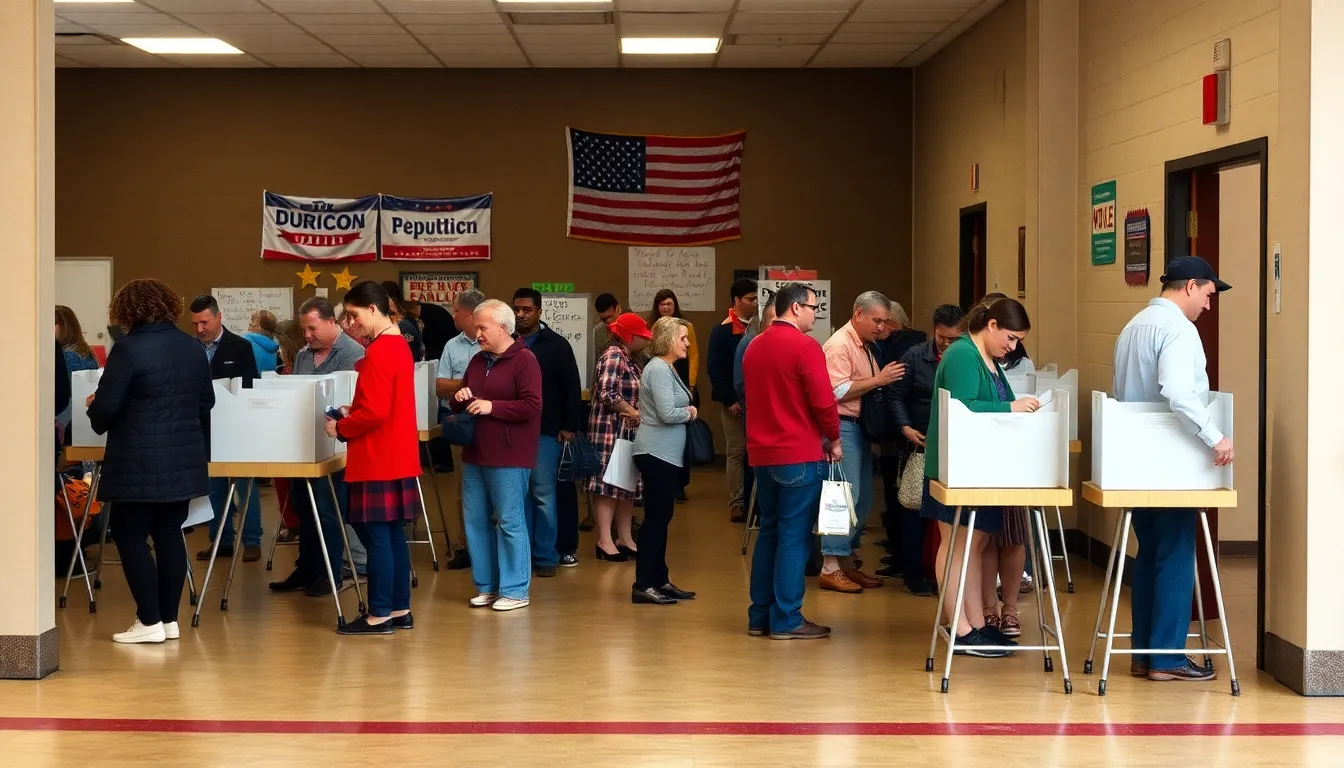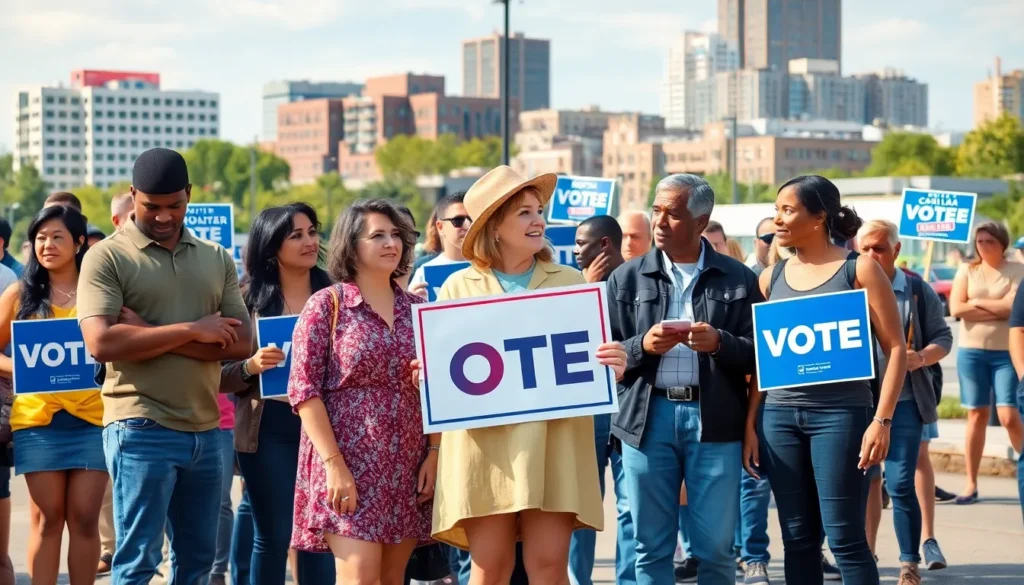Table of Contents
ToggleNorth Carolina is like that friend who can’t decide between two outfits – one minute it’s rocking a bold red and the next it’s draped in a calming blue. This southern state has become a political battleground, leaving many scratching their heads about its true colors. With a rich history of voting patterns that swing like a pendulum, understanding whether North Carolina leans red or blue is no small task.
As the 2024 elections loom, the stakes are higher than ever. Is it a Republican stronghold or a Democratic dream? Dive into the quirky world of North Carolina politics, where barbecue debates and college basketball rivalries take center stage. Buckle up as we unravel the complexities of this vibrant state and discover what really makes it tick in the political arena.
Overview of North Carolina’s Political Landscape
North Carolina’s political landscape showcases a blend of conservative and liberal influences. The state consistently ranks as a battleground region, with its political affiliations swinging between the Republican and Democratic parties during elections. Analysis of recent data reveals that North Carolina voted for Donald Trump in 2016 and Joe Biden in 2020, indicating its competitive nature.
Voter demographics play a crucial role in shaping party strength. Approximately 36% of registered voters identify as Democrats, while about 34% identify as Republicans. This close division highlights the potential for fluctuating electoral outcomes. Urban areas, such as Charlotte and Raleigh, lean Democratic due to their diverse populations, while rural counties often favor Republicans.
Election turnout also significantly impacts political dynamics. For instance, North Carolina saw a 75% voter turnout in the 2020 presidential election. High engagement levels usually correlate with race and key issues, such as healthcare and education, driving voter decisions.
Important factors influencing North Carolina’s politics include economic interests and social issues. Manufacturing, agriculture, and technology shape policy preferences across the state. Additionally, cultural elements like barbecue and college basketball frequently intertwine with political discussions, further enriching the local political landscape.
Anticipation is building as North Carolina approaches the 2024 elections. Candidates will address pivotal issues and strive to secure support from undecided voters. Understanding North Carolina’s evolving political affiliations provides essential insight into its potential trajectory in upcoming elections.
Historical Voting Patterns

North Carolina’s voting history illustrates its status as a battleground state, with frequent shifts between Republican and Democratic candidates. Examining the results of key elections provides insight into these changes.
Key Elections and Their Outcomes
In the 2016 presidential election, Donald Trump secured North Carolina’s electoral votes with 49.8% of the vote, while Hillary Clinton garnered 47.2%. Voter sentiment shifted in 2020, as Joe Biden won the state, receiving 48.6% compared to Trump’s 49.9%. Significant races include the 2018 governor’s election, where Roy Cooper, a Democrat, defeated the incumbent Republican governor, reinforcing the state’s unpredictable nature. Over time, gubernatorial and senatorial races have shown similar patterns, reflecting the state’s competitive political landscape.
Shifts in Political Affiliation
Political identity in North Carolina has evolved markedly over the past few decades. The state experienced a gradual increase in Democratic influence, particularly in urban regions like Charlotte and Raleigh. Historically, North Carolinians predominantly identified as Democrats until the 1990s, when Republican affiliation began rising. Recent surveys indicate a near split in party identification, with 36% of voters aligning with Democrats and 34% with Republicans. This close division highlights the potential for rapid changes in voting patterns and illustrates the ongoing complexity of the state’s political climate.
Current Political Climate
North Carolina’s political climate continues to shape the state’s identity as a battleground. With its history of fluctuating support, the upcoming elections draw significant attention.
Major Political Parties in North Carolina
Democrats and Republicans dominate North Carolina’s political scene. Roughly 36% of voters identify as Democrats, while 34% as Republicans. This narrow margin highlights the state’s competitive political landscape. Urban centers like Charlotte and Raleigh show strong Democratic leanings. Conversely, rural areas typically support Republican candidates. Third-party influences remain minimal, though they occasionally attract attention in local races.
Influential Political Figures
Several key figures shape North Carolina’s political discourse. Governor Roy Cooper, a Democrat, exemplifies the increasing influence of the party in urban areas. On the Republican side, figures like Senator Thom Tillis shape legislative agendas. Community leaders and activists also play vital roles, particularly in mobilizing voters during elections. Voter engagement efforts led by various organizations illustrate the grassroots movements gaining traction. This dynamic interplay between these figures fuels ongoing political discussions.
Voter Demographics and Trends
Understanding voter demographics and trends in North Carolina provides insight into its political landscape. The close division between party affiliations demonstrates the state’s competitive nature.
Urban vs. Rural Voting Behavior
Urban areas such as Charlotte and Raleigh predominantly lean Democratic. In contrast, rural counties often support Republican candidates. This contrast highlights a significant divide, influencing election outcomes. Voter turnout in cities tends to be higher, driven by diverse populations who prioritize issues such as education, healthcare, and public safety. With approximately 60% of North Carolinians residing in urban regions, these preferences shape the overall voting behavior. Consequently, major candidates prioritize urban engagement to secure votes.
Impact of Education and Socioeconomics
Educational attainment plays a crucial role in voter preferences. Individuals with higher levels of education frequently lean Democratic, whereas those with lower levels often favor Republicans. Additionally, socioeconomic factors influence political affiliations in North Carolina. For example, higher income populations tend to support Democrats, while lower-income residents show stronger loyalty to Republicans. Approximately 30% of voters with college degrees identify as Democrats. Identifying these trends can help candidates tailor their messages effectively leading to increased voter engagement.
Recent Election Analysis
North Carolina’s political landscape remains dynamic, with recent elections showcasing its battleground status. The results from key elections provide insight into trends and shifts in voter sentiment.
2020 Presidential Election Results
Joe Biden secured North Carolina’s electoral votes in the 2020 election, garnering 48.6% of the total votes. Donald Trump closely trailed with 49.8%, demonstrating the state’s competitive nature. Turnout in urban centers, such as Charlotte and Raleigh, significantly contributed to Biden’s success. Voter enthusiasm in these areas centered on education, healthcare, and social issues. Analyzing demographic shifts reveals that more affluent and educated voters leaned Democratic, reinforcing the significance of tailored messaging for different communities.
2022 Midterm Elections Insights
The 2022 midterms illustrated continued electoral competitiveness in North Carolina. Voter participation soared, with turnout reaching approximately 56%. Democratic candidates made notable gains in local races, aligning their platforms with public priorities. Key issues like abortion rights and healthcare resonated with constituents, leading to critical wins. In several districts, candidate strategies capitalized on rising concerns over education and economic stability, reflecting changing voter attitudes. The balance of party power remains close, highlighting the urgency for parties to engage undecided voters ahead of upcoming elections.
Future Outlook for North Carolina
North Carolina’s political future remains uncertain as the state approaches the 2024 elections. Voter demographics and political engagement continue to evolve.
Predictions for Upcoming Elections
Expect tight races in the upcoming elections. Battleground dynamics suggest fluctuating voter preferences. Polling indicates a nearly equal split between registered Democrats and Republicans, with Predominantly Democratic urban areas likely influencing outcomes. Recent trends point to increased participation driven by younger voters prioritizing issues like climate change and social justice. Candidates who resonate with these concerns may gain an advantage.
Factors Influencing Political Shifts
Several elements drive North Carolina’s political shifts. Education impacts party affiliation significantly. Roughly 30% of college-educated voters lean Democratic, while many without a degree tend to support Republicans. Socioeconomic factors also play a crucial role, as lower-income communities often align with conservative platforms. Additionally, rising issues including healthcare access and voting rights may sway undecided voters. Grassroots movements have gained traction, illustrating a growing influence on local politics and promoting voter mobilization. Understanding these factors proves vital for candidates aiming to succeed in upcoming elections.
North Carolina’s political landscape is a dynamic tapestry woven from diverse influences. As the state heads toward the 2024 elections it remains a key battleground with a near-even split between Democrats and Republicans. Urban centers continue to drive Democratic engagement while rural areas hold onto conservative values.
The evolving demographics and voter priorities will play a crucial role in shaping electoral outcomes. Candidates must navigate these complexities and address the pressing issues that resonate with voters. Understanding this intricate political environment is essential for anyone looking to grasp the true nature of North Carolina’s political identity as it stands on the brink of significant change.







